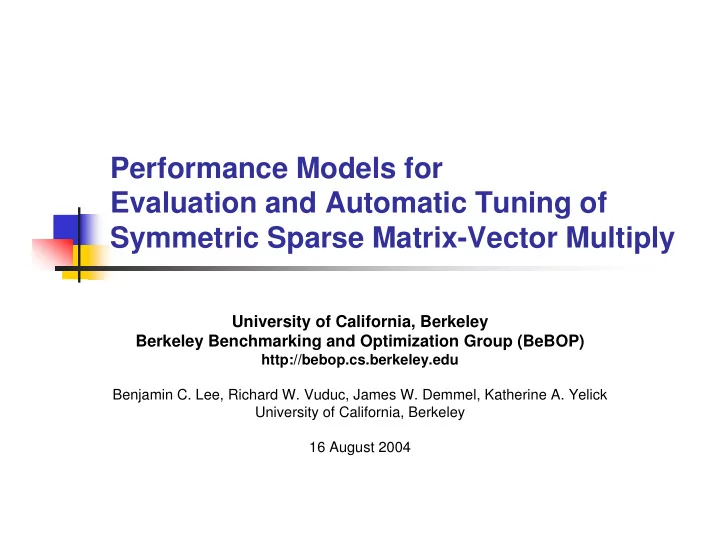

Performance Models for Evaluation and Automatic Tuning of Symmetric Sparse Matrix-Vector Multiply University of California, Berkeley Berkeley Benchmarking and Optimization Group (BeBOP) http://bebop.cs.berkeley.edu Benjamin C. Lee, Richard W. Vuduc, James W. Demmel, Katherine A. Yelick University of California, Berkeley 16 August 2004
Performance Tuning Challenges � Computational Kernels � Sparse Matrix-Vector Multiply (SpMV): y = y + Ax � A : Sparse matrix, symmetric ( i.e., A = A T ) � x, y : Dense vectors � Sparse Matrix-Multiple Vector Multiply (SpMM): Y = Y + AX � X, Y : Dense matrices � Performance Tuning Challenges � Sparse code characteristics � High bandwidth requirements (matrix storage overhead) � Poor locality (indirect, irregular memory access) � Poor instruction mix (low ratio of flops to memory operations) � SpMV performance less than 10% of machine peak � Performance depends on kernel, matrix, and architecture �������������������������������������������� �
Optimizations: Register Blocking (1/3) �������������������������������������������� �
Optimizations: Register Blocking (2/3) � BCSR with uniform, aligned grid �������������������������������������������� �
Optimizations: Register Blocking (3/3) � Fill-in zeros: Trade extra flops for better blocked efficiency �������������������������������������������� �
Optimizations: Matrix Symmetry � Symmetric Storage � Assume compressed sparse row (CSR) storage � Store half the matrix entries ( e.g., upper triangle) � Performance Implications � Same flops � Halves memory accesses to the matrix � Same irregular, indirect memory accesses � For each stored non-zero A(i, j) � y ( i ) += A ( i , j ) * x ( j ) � y ( j ) += A ( i , j ) * x ( i ) � Special consideration of diagonal elements �������������������������������������������� �
Optimizations: Multiple Vectors � Performance Implications � Reduces loop overhead � Amortizes the cost of reading A for v vectors X k v A Y �������������������������������������������� �
Optimizations: Register Usage (1/3) � Register Blocking � Assume column-wise unrolled block multiply � Destination vector elements in registers ( r ) x r c A y �������������������������������������������� �
Optimizations: Register Usage (2/3) � Symmetric Storage � Doubles register usage ( 2r ) � Destination vector elements for stored block � Source vector elements for transpose block x r c A y �������������������������������������������� �
Optimizations: Register Usage (3/3) � Vector Blocking � Scales register usage by vector width ( 2rv ) X k v A Y �������������������������������������������� �
Evaluation: Methodology � Three Platforms � Sun Ultra 2i, Intel Itanium 2, IBM Power 4 � Matrix Test Suite � Twelve matrices � Dense, Finite Element, Linear Programming, Assorted � Reference Implementation � No symmetry, no register blocking, single vector multiplication � Tuning Parameters � SpMM code characterized by parameters ( r , c , v ) � Register block size : r x c � Vector width : v �������������������������������������������� ��
Evaluation: Exhaustive Search � Performance � 2.1x max speedup (1.4x median) from symmetry (SpMV) � {Symm BCSR Single Vector} vs {Non-Symm BCSR Single Vector} � 2.6x max speedup (1.1x median) from symmetry (SpMM) � {Symm BCSR Multiple Vector} vs {Non-Symm BCSR Multiple Vector} � 7.3x max speedup (4.2x median) from combined optimizations � {Symm BCSR Multiple Vector} vs {Non-Symm CSR Single Vector} � Storage � 64.7% max savings (56.5% median) in storage � Savings > 50% possible when combined with register blocking � 9.9% increase in storage for a few cases � Increases possible when register block size results in significant fill �������������������������������������������� ��
Performance Results: Sun Ultra 2i �������������������������������������������� ��
Performance Results: Sun Ultra 2i �������������������������������������������� ��
Performance Results: Sun Ultra 2i �������������������������������������������� ��
Performance Results: Intel Itanium 2 �������������������������������������������� ��
Performance Results: IBM Power 4 �������������������������������������������� ��
Automated Empirical Tuning � Exhaustive search infeasible � Cost of matrix conversion to blocked format � Parameter Selection Procedure � Off-line benchmark � Symmetric SpMM performance for dense matrix D in sparse format � { P rcv ( D ) | 1 � r,c � b max and 1 � v � v max }, Mflop/s � Run-time estimate of fill � Fill is number of stored values divided by number of original non-zeros � { f rc (A) | 1 � r,c � b max }, always at least 1.0 � Heuristic performance model � Choose ( r , c , v ) to maximize estimate of optimized performance � max rcv { P rcv ( A ) = P rcv ( D ) / f rc ( A ) | 1 � r,c � b max and 1 � v � min( v max , k ) } �������������������������������������������� ��
Evaluation: Heuristic Search � Heuristic Performance � Always achieves at least 93% of best performance from exhaustive search � Ultra 2i, Itanium 2 � Always achieves at least 85% of best performance from exhaustive search � Power 4 �������������������������������������������� ��
Performance Results: Sun Ultra 2i �������������������������������������������� �
Performance Results: Intel Itanium 2 �������������������������������������������� ��
Performance Results: IBM Power 4 �������������������������������������������� ��
Performance Models � Model Characteristics and Assumptions � Considers only the cost of memory operations � Accounts for minimum effective cache and memory latencies � Considers only compulsory misses ( i.e., ignore conflict misses) � Ignores TLB misses � Execution Time Model � Loads and cache misses � Analytic model (based on data access patterns) � Hardware counters (via PAPI) � Charge a i for hits at each cache level � T = ( L1 hits ) a 1 + ( L2 hits ) a 2 + ( Mem hits ) a mem � T = ( Loads ) a 1 + ( L1 misses ) ( a 2 – a 1 ) + ( L2 misses ) ( a mem – a 2 ) �������������������������������������������� ��
Evaluation: Performance Bounds � Measured Performance vs. PAPI Bound � Measured performance is 68% of PAPI bound, on average � FEM applications are closer to bound than non-FEM matrices �������������������������������������������� ��
Performance Results: Sun Ultra 2i �������������������������������������������� ��
Performance Results: Intel Itanium 2 �������������������������������������������� ��
Performance Results: IBM Power 4 �������������������������������������������� ��
Recommend
More recommend